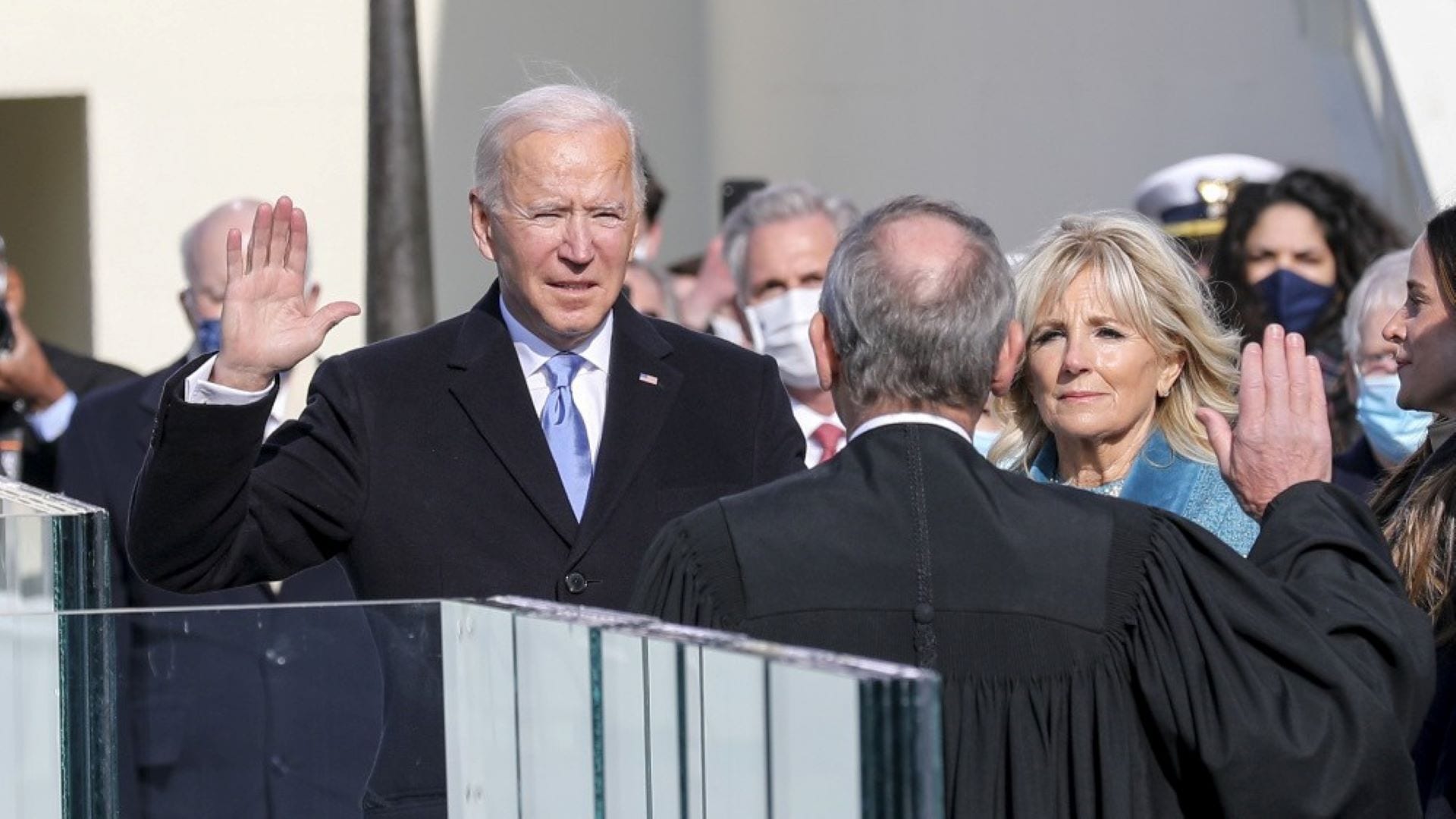Joe Biden, the 46th President of the United States, has now been in office for several months. On April 28, 2021, he delivered his first public address to a joint session of the United States Congress, wherein he outlined many of his policy priorities.
The president used this opportunity to promote his substantial spending plans, which represent an unprecedented increase in the size and scope of the U.S. government. In his speech, President Biden also covered the topics of foreign policy, education, public health, and social issues.
Let’s take a deeper look at how his vision for the U.S. will affect the direction of the country.
Biden’s massive spending spree
In March, President Biden signed the unprecedented $1.9 trillion American Rescue Plan Act of 2021 into law. Key components of this stimulus bill include, among others, an unemployment extension, increasing food stamp benefits, expanding the child tax credit, and $1,400 direct payments to individuals meeting certain criteria.
Biden’s agenda includes further public spending, as set out in his American Jobs Plan and American Families Plan. These two proposed plans focus mainly on infrastructure, long-term care for the elderly and disabled, housing, clean energy, job creation, education, and childcare.
Overall, the cost of Biden’s new plans exceeds $6 trillion, a sum comparable to the entirety of the federal government’s spending throughout 2020. The national debt has already risen to $28 trillion under Donald Trump, and is projected to increase even further under President Biden. As a percentage of national GDP, it could well be on course to exceed the record set in 1946 if the federal government continues to borrow.
From the perspective of your wallet, and indeed broader fiscal responsibility, increased public spending on such an unprecedented scale should certainly be a major cause for concern.
Biden will return to Obama-era rhetoric on tax
During his speech to Congress, the president labelled his plans “a once in a generation investment in America itself.” His administration stated that these spending hikes would be funded by tax changes primarily targeting wealthy Americans, seeking to raise the corporate tax rate from 21 to 28 percent.
Much like Obama before him, the president asserted his view that corporations and wealthy individuals must “begin to pay their fair share.” Clearly, even America’s wealthy elite do not have that kind of capital to tax and spend, let alone the whole of the country in the post-covid era. This position will evidently involve alternate, unspoken financial tools or greater taxation on the middle class.
His other mistake is to focus on the corporate tax rate. It is clearly consumers and employees who will bear the brunt of the tax hike, not wealthy elites, since any additional tax costs will merely be passed down.
In terms of income tax, the president has proposed reversing his predecessor’s 2017 tax cut for the income bracket of those he defines as wealthy, meaning the roughly 1.8 percent of Americans who earn more than $400,000.
For these individuals, Biden wants a tax rate of 39.6 percent as opposed to the current 37 percent. He has also put forward plans to dedicate more resources to enforcement with regards to tax evasion. However, the amount of money this would raise is trivial compared to what the president intends to spend.
Biden wants more wage controls and intervention
The president is intent on seeing a $15 per hour minimum wage implemented nationwide. Despite its widespread popularity in many circles, the proposed policy risks worsening the already high unemployment rate, and would be particularly disastrous for employees and business owners in parts of the U.S. where the cost of living is lower.
Biden has already mandated a $15/hour minimum wage for all federal contractors, beginning in March 2022.To add insult to injury, the president also expressed his protectionist credentials when it comes to trade, while also taking aim at the gig economy, where he wants more state oversight and regulation.
Finally withdrawing U.S. troops from Afghanistan
Last month, President Biden made a historic announcement, stating his intention to withdraw all U.S. troops from Afghanistan by September 11, 2021. The president has asserted that U.S. involvement in the prolonged conflict no longer aligns with the country’s current priorities.
As such, it appears that after almost two decades, America’s presence in Afghanistan will finally come to an end.
There is significant opposition to Biden’s withdrawal plan, including from the “old guard” within his own party. For instance, Hillary Clinton has voiced her disapproval, warning of potential consequences such as a surge in terrorist activity.
Many on the right are also unhappy with the president’s position, with some suggesting that in the absence of U.S. involvement, rival powers such as Russia or China could expand their influence in the region.
How to compete with China
Much like his predecessor, Biden views China’s growing influence as a long-term threat to American interests, both in terms of geopolitics and ideology. On this subject, he called out Xi Jinping as an autocrat who sees no future for democracy. He also echoed Donald Trump’s sentiments by urging people to “buy American.”
The president made his position eminently clear, stating that, “We’re in competition with China, and other countries, to win the 21st century.” Competition with China is given as another rationale for his enormous spending proposal.
However, it seems bizarre that the way for America to compete with China would be to have further restrictions on personal and economic freedom, greater government oversight, and ever-increasing debt.
Considering how many governments have taken unprecedented measures in response to the COVID-19 pandemic, and have looked to authoritarian China for ideas, there are reasons for concern around the position of the U.S. as an ideological counterpart to the Chinese Communist Party.
The global human rights situation
Joe Biden has been outspoken on certain global issues, particularly in condemning human rights violations in Russia. Furthermore, his Secretary of State, Anthony Blinken, expressed condemnation of China’s egregious violations and “effort to commit genocide” against the Uyghur people in Xinjiang.
The Biden administration has called for countries around the world to take “concrete actions” to prevent companies from being in any way complicit with this repression or benefiting from the forced labor of Uyghurs.
Last month, Biden became the first U.S. president to officially refer to the series of massacres perpetrated by the Ottoman Empire against its Armenian population in 1915 as a genocide. He stated that, in remembering those who were killed, we “recommit ourselves to prevent such an atrocity from ever happening again.”
However, Turkey’s foreign ministry warned that this move risked undermining their relationship with the U.S., something which many have seen as already deteriorating over recent years.
On the domestic front, the president, a staunch critic of his predecessor’s immigration policies, has pledged to begin reuniting families separated at the U.S.-Mexico border.
However, despite his condemnation of the Trump administration keeping “kids in cages,” and Kamala Harris referring to the policy as a “crime against humanity,” very little seems to have changed in the early months of Joe Biden’s presidency, despite the rebranded “migrant facilities for children.”
Biden is not known for radical immigration reform, but the president has at least reversed the trend and seemingly overcome initial hesitancy by raising the cap on refugees to 62,500 for this year. This is in stark contrast to the record-low cap of 15,000 under the Trump administration.
Despite serious concerns around Joe Biden’s economic plans and his timid approach to immigration reform thus far, perhaps one of the most promising areas for change over the coming years from a pro-liberty perspective is drug policy reform.
A growing number of states are decriminalizing and legalizing marijuana for both medical and recreational purposes, along with other drugs in some cases. This trend is likely to continue, although we must be careful in where credit is attributed, especially considering the record of senior political figures on the issue of drugs.
To read more of our content on U.S. politics and other current affairs, be sure to check out our News and Press cluster page by clicking on the button below.
This piece solely expresses the opinion of the author and not necessarily the organization as a whole. Students For Liberty is committed to facilitating a broad dialogue for liberty, representing a variety of opinions.









